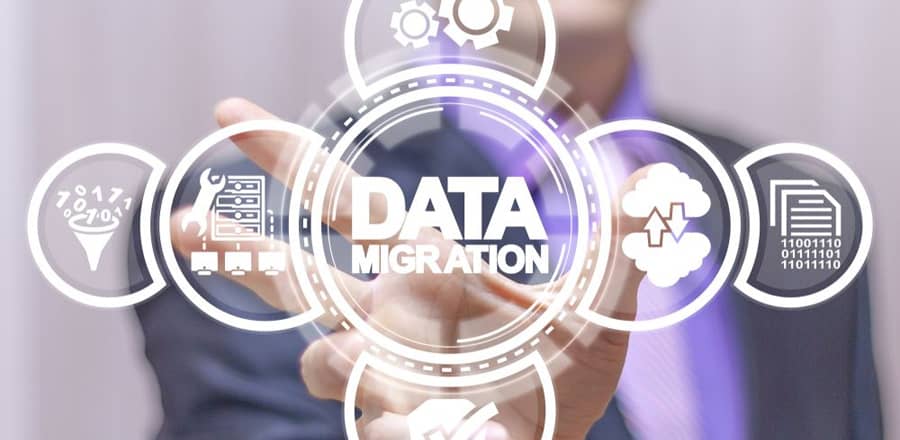Data Migration
IT Solution
We offer data migration resources and data migration strategy to ensure the transition from legacy to the cloud is a smooth one. We begin by exploring the quality of legacy data and explore options for moving to the cloud.
It is only after going through the viable options that we select the one which is best suited for the requirement of our clients.
Before proceeding, we conduct detailed research and analysis to ensure a seamless transfer. We advise clients on all aspects of data migration process, which includes assessment, planning, procurement, and delivery. We place our clients first and make sure their data works in perfect harmony all the way through.
Data migration services from one system to a new environment that require consistency of usage. It differs from data movement and integration and does not involve steps like extraction or transformation.
In 2011, a report by Bloor found approx. 38% of projects use the data migration methodology that fails to meet the deadline or the pre-defined budget plan. There is no clear method used by firms to approach it.
Most companies make use of customized methodologies where they may determine pre-migration scoping, risk factors, and assess the core processes on various factors.

What is Data Migration?
A database is the collection of information that is organized in the manner to be easily accessible, manageable, and edited. It is properly managed by a DBMS system that can create and decide how the data will be structured.
It provides ways to get answers to queries of the users who can extract exact reports and information from the tables. Such systems allow storing a large amount of data of multiple work years which can be modified/ edited when required by the administrator, as the ability to control the access varies from one to another.
Some systems are migrated from one domain to another. It is important to conduct such transformation without compromising the security or losing any crucial information. In such conditions, the servers are upgraded and the information must be moved accurately.
Data migration services involve transferring data to be a new system, running on a different operating system, or on a cloud-based system supported by new technical tools, where the information provided is based on the type of source and target.
Such a process needs to identify the risks and activities in advance. There are many risks associated with such activities as it can delay the deployment of new applications and increase costs, data loss, and downtime.
The key steps involved in data migration services are –
-
Data profiling – It is the phase when one ensures that the historical data should be modified properly. The profiling should be carried out in certain specific parts of the data to get proper format, structure, and conformance.
-
The quality definitions of the elements, attributes, and relationship in the source should be determined. All such rules should be listed at the element level like a table or flat file.
-
Data cleansing should be manually carried out and it can be automated where splitting the rules into two allows the firm to concentrate on a manual process, at the same time as the migration experts – design and develop the automated systems.
-
Data security is a political issue with continuing high profile data loss, hence, the solution should be able to provide security to the sensitive customer or corporate data. One should examine the value of the data loss, in case of, any security breach.
-
The involved legal obligations and statutory measures should be checked.
-
One may have to provide training to the personnel and outside consultants and partners, and conduct testing and information sessions where devices and protocols for sending messages and using storage should be established.
-
In the last stage, the retirement plan for the current system is determined where one has to recover all the licenses, conduct machine disposal, cancel all related support contracts, redevelop staff, and close systems/ old servers.

What are the different types of Data Migration?
Data migration services can be of 4 types –
Storage – It involves the process where the blocks of data from one type of hardware are moved to another on hard disc or tapes.
Database – In such methods, the entire data from one type of database can be extracted and recreated into another system through technical processes or by using the software.
Application- The vendors may depict software on a specific database but depending on the requirement of the user, the database system may require changing the back end to a stronger alternative DBMS solution.
Such a system may require a substantial transformation of the data where almost every system operates on a specific model.
Business Process Migration- Some firms require a complete change in the method that is adopted by one type of business. Such systems need tools that should be replaced and updated at the time of merger or acquisition and the data migration planning can be done from one form to another to another store or application.
Cloud- These days many small firms want the on-premises system to be shifted to cloud. This is not the same as backing up to the cloud. It requires moving resources from the source to a completely new environment.

How to use Samsung Data Migration?
Samsung allows transferring all existing files and programs from HDD or SSD to a new Samsung drive like Samsung 850 EVO SSD, Samsung 840 Pro SSD. One can clone a large capacity or small size database where the latest version can support Windows 10.
Samsung data migration process involves the following steps–
-
Connect the new Samsung SSD to the PC based or Windows 10 OS.
-
Mention the source and target drive and then click the start button.
-
One gets a warning reminder where you are asked if you need to delete the data on the target disk (when the file on the source is open, it cannot be cloned, hence, you need to close all the running files to start the process).
-
One the system starts cloning, it shows a message when the hard drive has been successfully cloned.
Disk Clone Wizard can be used to clone the entire hard drive to another. Migrate OS to SSD can be used to clone the operating system files of the windows and other programs and partition clone wizard can be used to copy a partition to another SSD.
For moving from Windows 7 to Windows 10 – Windows 10 Migration accelerator can be used. Acronis True Image can be used to back up folders, files and to replicate instructions in local backup in the cloud.
It has the feature for Active Disk Learning that can create a replica of Windows or Mac at the time when the operating system is in use and one can reboot the system to start the process of transferring files.
It supports Windows XP, FAT 12 / 16/ 32, exFAT, Ext2/ 3/ 4 and NTSF. It has certain features like the ability to manage disks, check file systems, align SSD partition, and others.
Todo PCTrans offers free transfer of photos, files, videos and music, and applications from old PC to a new. It can be used to transfer from XP or Windows 7 and other 32-bit to 64-bit Window versions.

Data Migration Software
Data can be moved between hard disks, through specialized tools to help users to migrate among disks. Intel released the Intel Data Migration Software for those who buy its hard drive but it can work on SSD drives that are initialized as GUID and partitioned (NTFS).
Similarly, Samsung has designed it for users who want to migrate from an old storage device to a new Samsung SDD. Many users get error messages related to such processes because it works only on their branded hard drive. If the user makes use of multiple hard drives, it may create issues.
Samsung smart switch is the 2020’s popular option widely used on Google’s mobile OS. It provides cross-platform, multiple device wireless transfer with or without the USB. It supports calendars, pictures, messages, contacts, call logs, videos, alarms, documents, and can transfer app data or home layouts.
What is the Data Migration Process?
Some of the key steps involved in the data migration methodology are:-
-
Identifying and exploring the source system, technology, background/environment, supporting software systems/applications, and hardware requirements.
-
Examining the quality of the services offered by different types of solution providers and identifying the offers that match the requirements of the client.
-
Get an exact analysis of various solutions to prevent inaccuracy, inconsistencies, and security hacks.
-
Determining the architecture, design requirements, testing features/methods, and supporting parallel running systems to avoid loss of work during the process of shifting.

-
Preparing subsets of the data at each level of progression and testing in parallel.
-
Final execution and shutting of the previous system.
-
Revising the new system, audit trails logs, examining / quality tests, and determining methods to retire the old.
-
After accomplishing the target, the firm needs to work toward ongoing improvement and monitoring of the new system.

What are the differences between Data Migration vs Data Conversion vs Data Integration?
Data migration is moving data between hardware devices, locations, and environments. The system involves various stages of quality assurance, cleansing, profiling, validation, and testing.
It is the process where the firm gathers the key information from multiple resources at one place that can be extracted and viewed through a single program or automated script and it also supports the automatic transfer.
The process may take months to complete where the user need to follow the steps –
-
Get a review of the current system, map the tables and find unique columns and tables.
-
Get the discrepancies or inconsistencies to sort the issues.
-
Track the tables to be transferred to the new system
-
Transfer and test the new solution into the production.
Data conversion means transforming the type of data from one type of application to a new where you extract the data from one or many different systems and transform it and then load it.
The steps involved in the data migration methodology include –
-
Identifying data to be imported into a new system that is the business requirement.
-
Extracting it into a flat file and staging table.
-
Translating, converting, and formatting it.
-
Loading it into an interface table using SQL Loader or DB link or another mechanism after validation and then launching the standards interface to load the tables.
-
In case, you are using APIs, the process involves fetching data and then validating it and then, calling the API to import.
Data integration involves merging or bringing together two different types of database systems to get a unified view and comparatively clear analytics.
It involves the collaboration in the two systems to combine the business and technical processes in the manner to provide an efficient business solution to the end-user.
The process supports analytical aligning, combining, and effectively presenting reports to the client.

How do I use the AWS Database Migration Service?
AWS database migration service allows both homogenous and heterogeneous movement like from Oracle to Oracle and Oracle to SQL. One can easily replace the data and consolidate systems.
It helps to move the live terabyte-scale database to a cloud where the automated services work to set, manage a replication instance.
The service monitors the replication and the health of the instance. It supports different migration scenarios and networking options. One of the endpoints should always be in AWS in such cases to EC2 instance or on-premise or run on RDS.
The source and destination can reside in the same VPC (virtual private cloud) or on two separate VPCs (if one is migrating from one cloud-based database to another).
One can set up the first by creating the target, migrating the scheme, setting up the data replication process, and then initiating the process.
The steps are –
-
Start by opening up the AWS Database Migration Service Console and then click the Create Migration method.
-
You need to select the source and target and task on the replication instance.
-
Set properties of the replication instance.
-
Connect the source and target and then create a task.
-
Before starting the process, you should create a document to ensure all the essential steps are taken to get an accurate outcome.

How to Plan a Data Migration?
Some crucial steps in the data migration services are –
-
The exact method should use a verified system for data extraction.
-
Migration and transformation should be made into the target structure.
-
One should map rules or details.
-
The methodologies should be able to overcome quality constraints, structural issues, and be able to provide tools.
-
After implementation, the system should pass the unit test specifications and the integration test.
-
The method should have a recovery option for each stage and there should be steps taken by the firm to “go live” on the plan.
In the pre-migration state, the user needs to assess the viability of the process that may involve both the business and IT teams, who try to assess things to identify the data security and governance issues.
They determine the key resources, deadlines, and quality parameters. They may try to determine the project delivery and estimate the risks. An appropriate training plan, project approach, and workflow are defined in the later stage.
The steps to get the scope of the data migration methodology is identified where –
-
One decides the strategic delivery vehicles for applications.
-
Use the pre-migration app compatibility assessment.
-
Create a detailed scope report. Such documents include the functions to be carried out in the app where the existing app should maintain or decommission.
-
Manage data migration resources, conduct cleansing, or handle quality management practices.

Why a Data Migration Strategy is Important?
Historically, the Mainframe held the unquestionable lead in reliability, serviceability, availability, and security but the modern systems evolved to become more innovative and flexible as compared to the mainframe.
The maintenance cost of such a system was very high; hence, the data was shifted to Microsoft based system to achieve the following goals-
-
Data profiling and analysis
-
Shifting data from the legacy-based system to modern systems
-
Reduce the operational and maintenance cost
-
Provide advantage and superiority over competitors
-
Lower operational cost
-
Provide scalable, efficient solution for better customer support
The key benefits of modern data migration strategy are –
-
Comprehensive data integrity
-
Reduction of storage and maintenance cost
-
Minimizing loss of data, boosting efficiency and effectiveness of applications
-
Increasing scalability of resources to meet the growing need of business datasets
-
Such methods help to get fast, scalable, easy to manage, and low-cost alternatives to heavy data maintenance plans, especially in conditions, where the firm’s data is spread across multiple units in multiple geographical locations.

